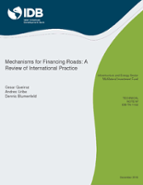Mechanisms for Financing Roads: A Review of International Practice
Date
Oct 2016
In the last two decades there has been an increased contribution of the private sector, through some form of public-private partnership (PPP), to finance transport infrastructure in general, and roads in particular, in both the developed and developing worlds. Such contribution has helped several countries to maintain, rehabilitate and expand their road networks, including the construction of new motorways, bridges and tunnels. Some governments have increased the public contribution to potential PPP road projects to make them attractive to private investors. Such support may take the form of grants (or subsidies) to project construction, as well as availabilitypayments and operational grants or minimum revenue guarantees during the operational phase of the PPP project. Nevertheless, there are projects that will not be able to attract private financing and will have to be financed with only public funds. The main objective of this paper is to provide an overview of the most commonly used means to charge road users to generate financial resources for supporting PPP projects or to finance totally public projects. Such charges include inter alia fuel taxes, vehicle taxes, vignettes, and tolls. A brief survey of road user charging systems in selected European countries is presented. Consideration is given to different forms of PPP, including a review of potential application of the World Bank Toolkit for PPP in Roads and Highways as an instrument to help decision-makers and practitioners
to define the best PPP approach for a specific country. Developing and transition economies can also take advantage of guarantees offered by international financial institutions, an example of which is the World Bank's partial risk guarantees that can increase a project's attractiveness to
private investors through lower interest rates and longer maturities of loans.
to define the best PPP approach for a specific country. Developing and transition economies can also take advantage of guarantees offered by international financial institutions, an example of which is the World Bank's partial risk guarantees that can increase a project's attractiveness to
private investors through lower interest rates and longer maturities of loans.



